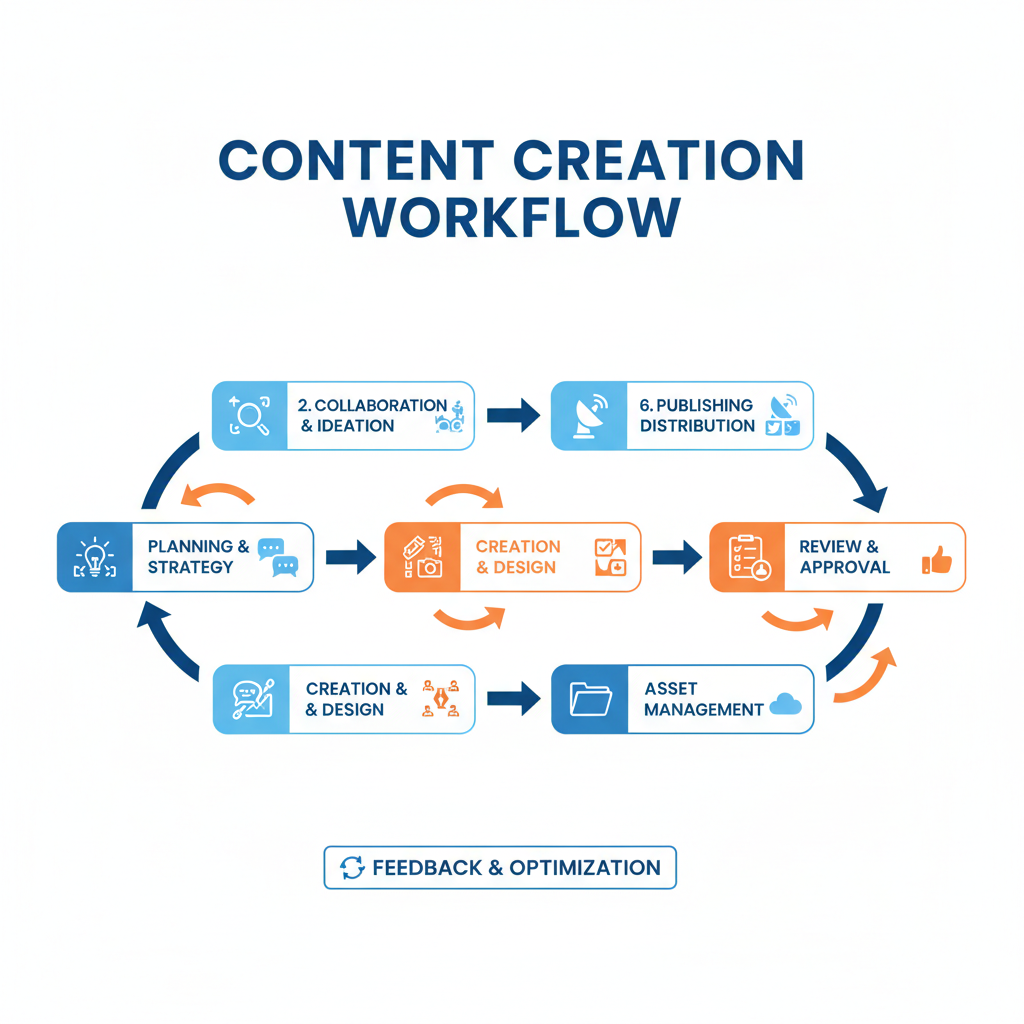Top Content Creation Management Software in 2024
Discover the best content creation management software in 2024, with key features, comparisons, and strengths to boost your marketing efficiency.

Understanding Content Creation Management Software
Content creation management software is a category of tools designed to streamline the planning, collaboration, production, and distribution of digital content. In modern marketing, brands rely on these tools to organize their editorial calendars, coordinate cross-functional teams, and maintain content quality across multiple channels. As campaigns become more complex and content output increases, having a centralized platform for content creation management software benefits is now a necessity rather than a luxury.

At its core, content creation management software acts as the nerve center for content marketing operations. It provides a single interface for project tracking, asset storage, communication, and publication scheduling — all aligned to brand objectives.
---
Key Features to Look For
When evaluating content creation management software, certain capabilities stand out as critical for high-performance teams. Understanding each feature will help you select the most suitable platform for your organization.
Workflow Management
A robust workflow module allows you to map tasks, assign responsibilities, and monitor deadlines. Automated reminders and visual task boards help keep projects on track.
Collaboration Tools
Real-time commenting, file sharing, and @mentions ensure teams can communicate without endless email threads.
Asset Library
A centralized content repository saves time hunting for images, videos, or documents, while version control prevents confusion over multiple file edits.
Publishing Tools
Integration with social media platforms, blogs, and CMS systems lets you schedule and post directly from the software, reducing manual steps.
---
Top Platforms in 2024
Below is a comparison of leading content creation management solutions for 2024, highlighting their main strengths and weaknesses.

| Platform | Main Strengths | Main Weaknesses |
|---|---|---|
| Trello | User-friendly Kanban boards, flexible structure | Limited native publishing tools |
| Asana | Powerful task management, multiple project views | Steeper learning curve for new users |
| Monday.com | Highly customizable workflows, vibrant interface | Can be overwhelming with too many options |
| Airtable | Database-like flexibility, excellent filtering | Requires setup time for optimal results |
| Notion | All-in-one workspace, flexible templates | Lacks advanced automation natively |
| CoSchedule | Strong marketing-focused scheduling, analytics | Niche focus may not fit non-marketing tasks |
---
Strengths and Weaknesses in Detail
Trello
- Strengths: Simple, highly visual boards make it easy for beginners to jump in quickly.
- Weaknesses: Better suited for planning than execution due to limited integration with publishing platforms.
Asana
- Strengths: Offers list, board, timeline, and calendar views to fit various management styles.
- Weaknesses: Can feel complex without proper onboarding, especially for non-technical users.
Monday.com
- Strengths: Adaptable to almost any workflow, with color-coded designs for clarity.
- Weaknesses: Too many available templates can cause decision paralysis.
Airtable
- Strengths: Combines spreadsheet familiarity with robust relational database features.
- Weaknesses: Benefit is maximized only after customizing tables and forms.
Notion
- Strengths: Brings notes, databases, and tasks together; excellent for knowledge management.
- Weaknesses: Automation tools need third-party integration to rival others.
CoSchedule
- Strengths: Tailored specifically for marketing teams; includes in-depth scheduling and analytics.
- Weaknesses: Less useful outside of marketing workflow contexts.
---
Integration Capabilities
Most modern content creation management software leverages API connections or native integrations. Essential categories include:
- Social Media Platforms: Direct posting and analytics from Facebook, Twitter, LinkedIn, Instagram.
- CMS Systems: Such as WordPress, Drupal, or HubSpot.
- Analytics Tools: Google Analytics, SEMrush, or proprietary reporting dashboards.
Integration eliminates redundant work by syncing tasks, deadlines, and campaigns across different systems, ensuring a seamless content pipeline from ideation to distribution.
---
Tips for Choosing the Right Software
When selecting a solution:
- Team Size: Small teams may thrive with Trello or Notion, while large enterprises benefit from Monday.com or Asana.
- Content Type: Choose platforms with relevant templates and asset support (e.g., Airtable for structured data-heavy projects).
- Budget: Weigh subscription costs against productivity gains and potential ROI.
- Scalability: Look for tools that grow with your content volume.
- Ease of Use: User-friendly interfaces encourage faster adoption.
---
Onboarding and Training Best Practices

Maximizing software adoption requires:
- Initial Workshops: Demonstrate key features and workflow alignment.
- Role-Based Training: Tailor sessions for writers, designers, and managers.
- Documentation: Maintain internal guides for common processes.
- Continuous Feedback: Encourage users to report bottlenecks for iterative improvement.
---
Case Study: Boosting Productivity at Brand X
Brand X, a mid-sized e-commerce company, migrated from spreadsheets to Asana in early 2023. The marketing department struggled with missed deadlines and scattered files. Within six months:
- Missed deadlines decreased by 60%.
- Cross-team communication improved, with design and copy teams collaborating in unified task threads.
- On-time campaign launches boosted seasonal sales by 25%.
This transformation illustrates the tangible benefits of aligning teams through a centralized content creation management software.
---
Future Trends in Content Creation Management Tools
Looking forward to 2024 and beyond, several trends are shaping the next generation of tools:
- AI-Assisted Content Planning: Predictive analytics for content topics and optimal posting schedules.
- Automation: Automated asset tagging, social media posting, and report generation.
- Unified Content Ecosystems: Platforms evolving to cover ideation, creation, distribution, and measurement in a single interface.
- Voice and AR/VR Support: Expanding capabilities to manage non-traditional content formats.
These innovations promise greater efficiency, better insights, and enhanced creative control.
---
Conclusion and Next Steps
Selecting the right content creation management software requires balancing features, scalability, integration, and team dynamics. Begin with a clear audit of your content processes, identify gaps, and match these to the strengths of the reviewed platforms.
Actionable Steps:
- Define your content workflow and bottlenecks.
- Shortlist 2–3 platforms that align with your needs.
- Trial each option with a pilot project.
- Gather team feedback before committing to a subscription.
By investing thoughtfully, brands can ensure their digital marketing strategies remain agile, consistent, and impactful.
Explore the tools discussed here, start testing today, and position your team to excel in the dynamic world of digital content creation.



